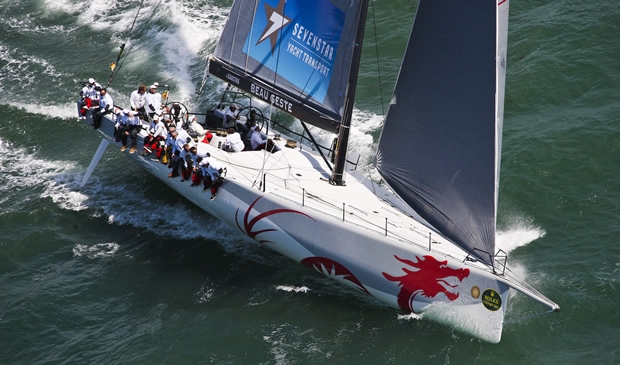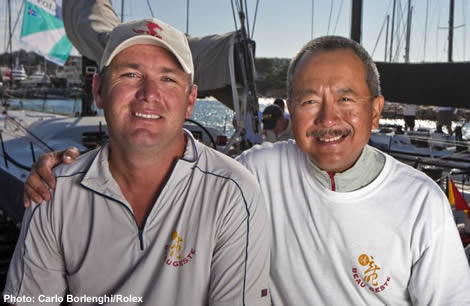
Beau Geste breaks in half
Karl Kwok's Farr 80 Beau Geste nearly did a 'One Australia' after she suffered severe damage to her hull and deck in the Royal Akarana Yacht Club's Auckland to Noumea race during gale force winds. At the time she was lying 100 miles east of Norfolk Island (mid-way between New Zealand and Noumea).
The Rescue Coordination Centre New Zealand was contacted by Beau Geste's skipper Gavin Brady at 1900 local time (0800 UTC) yesterday advising that the yacht had suffered damage to its deck and hull which was continuing to deteriorate. The RCCNZ issued a request for assistance from nearby vessels and the cargo ship Winchester Strait responded and was making its way to the stricken yacht, although she was subsequently released.
At 0600 local time (1900 UTC last night) Beau Geste was making her way towards Norfolk Island, accompanied by the fishing boat, Advance 2, that joined the stricken vessel at 0330 local time in the morning. At 0600 Beau Geste was 17 miles southeast of Norfolk Island.
RCCNZ search and mission coordinator Tracy Brickles provided an upate. "The crew will wait for daybreak (around 7am NZ time) to properly assess the damage on board and ideally look to anchor the yacht as close to shore as they can." She added that a nearby bulk carrier was also available to provide shelter to Beau Geste from the conditions if required.
At 0830 local time the RCCNZ reported that the wind and sea conditions were slowing the progress of Beau Geste as she attempted to reach sheltered waters off Kingston on the south side of Norfolk Island. The yacht was making its way around Phillip Island, to the south of Norfolk Island, in order to reach safe anchorage. This was a longer but more sheltered route.
Beau Geste was still being accompanied by the fishing vessel Advance 2, while the bulk carrier, Katherine, was making its way towards the yacht to provide some shelter from the wind and sea conditions as she approached the shore. Neville Blakemore, Search and Rescue Mission Coordinator at the RCCNZ commented: "It could take a while for Beau Geste to reach sheltered waters as the damage is significant and the crew has to take a great deal of care as they turn into the conditions. However, they are very experienced, and are well supported with the two nearby vessels assisting."
Kingston does not have a port or marina, so Beau Geste has been forced to anchor. With the wind in the northwest, the island is providing enough shelter. At 1130 local time the RCCNZ reported that Beau Geste had succeessfully anchored off Kingston Jetty and all 18 members of her crew were safely ashore, and in good spirits.
"It would have been a long night for the crew, in difficult conditions, but the boat has made safe anchorage under its own power," Blakemore said. "A support vessel was on hand throughout the night in case the crew had to abandon ship."

In an illuminating interview with Radio New Zealand subsequently Beau Geste skipper Gavin Brady described what happened: "We were settling down for a reasonably strong cold front that was going to pass through and we hit a reasonable wave – it certainly wasn’t anything out of the ordinary - and there was an almighty bang and we weren’t sure exactly what broke until one of the crew members was walking down the deck and they stumbled on a large crack that went all the way across the boat and then we looked over the side and there was a big crack that was going all the way down to the keel, down the side of the boat, and that crack went through to the inside of the boat, so effectively the boat completely broke in half."
Aside from One Australia, this was similar to the catastrophic failure that befell Tituoan Lamazou's 143ft TAG Heuer Jules Verne Trophy monohull contender during her first sea trials back in 1993.
Brady continued: "We took on quite a bit of water, we had the pumps working. We dropped all the sails and assessed the situation, what shipped was around us, we numbered off and got ready to get into the liferafts and we thought ‘let’s keep the boat afloat as long as we can'.
The Kiwi former America's Cup helmsman admitted they didn't know much about Norfolk Island, as it wasn't a place they'd normally visit, however they had an effective SAR operation and a rescue boat reached them when they were 50 miles out, for which he said he and the crew were extemely grateful.
"We were just nursing the boat all the way in, pumping. We were ready to get into the liftrafts to transition into the rescue boat at any time. But we managed to get into the Norfolk shoreline where the boat is sitting on anchor waiting to see what we can do with the boat next."
Brady said that they had been extremely lucky that the boat hadn't immediately broken in half and sunk to the bottom. At the time half of the crew had been down below and if this had happened then they might have had 30 seconds to get out of the boat and there might well have been a very different outcome. "Not a single person on the boat wasn’t scared. When you look down the side of the boat and you see a crack going all the way under the boat. What everyone probably thought about was One Australia in 1995 when it sank in 1 minute 30 and how quickly you saw that mast disappear below the water."
Brady said that Beau Geste has covered 55,000 miles since she was launched in 2009 and during this time she has suffered three "fairly severe structural problems". He reckoned that at the time of the incident they were only pushing the boat to 70% of its potential. "You have to say if you are already slowly the boat down to 70% and it is still breaking, there are obviously some inherent problems in the design," said Brady, drawing parallels with some of the issues boats have been experiencing in the Volvo Ocean Race.
It has yet to be decided how they will salvage Beau Geste. One wonders if she will still be afloat in the morning...










Latest Comments
Mats Ohlsson 06/06/2012 - 10:48
This is sertainly a structual fatigue issue. In terms of envelope pushing design of Carbon Fibre structures, the ocean racing community is leading the way. So is this an issue which applies only to marginally under dimensioned structures or is it an issue which lurkes in all carbon structures. If so, what about aircraft wing sections or your 5m$ cruising yacht investment? More research into the fatigue issues of Carbon Fibre please.Add a comment - Members log in